ECO mode JEEP COMMANDER 2009 1.G Repair Manual
[x] Cancel search | Manufacturer: JEEP, Model Year: 2009, Model line: COMMANDER, Model: JEEP COMMANDER 2009 1.GPages: 519, PDF Size: 9.78 MB
Page 333 of 519
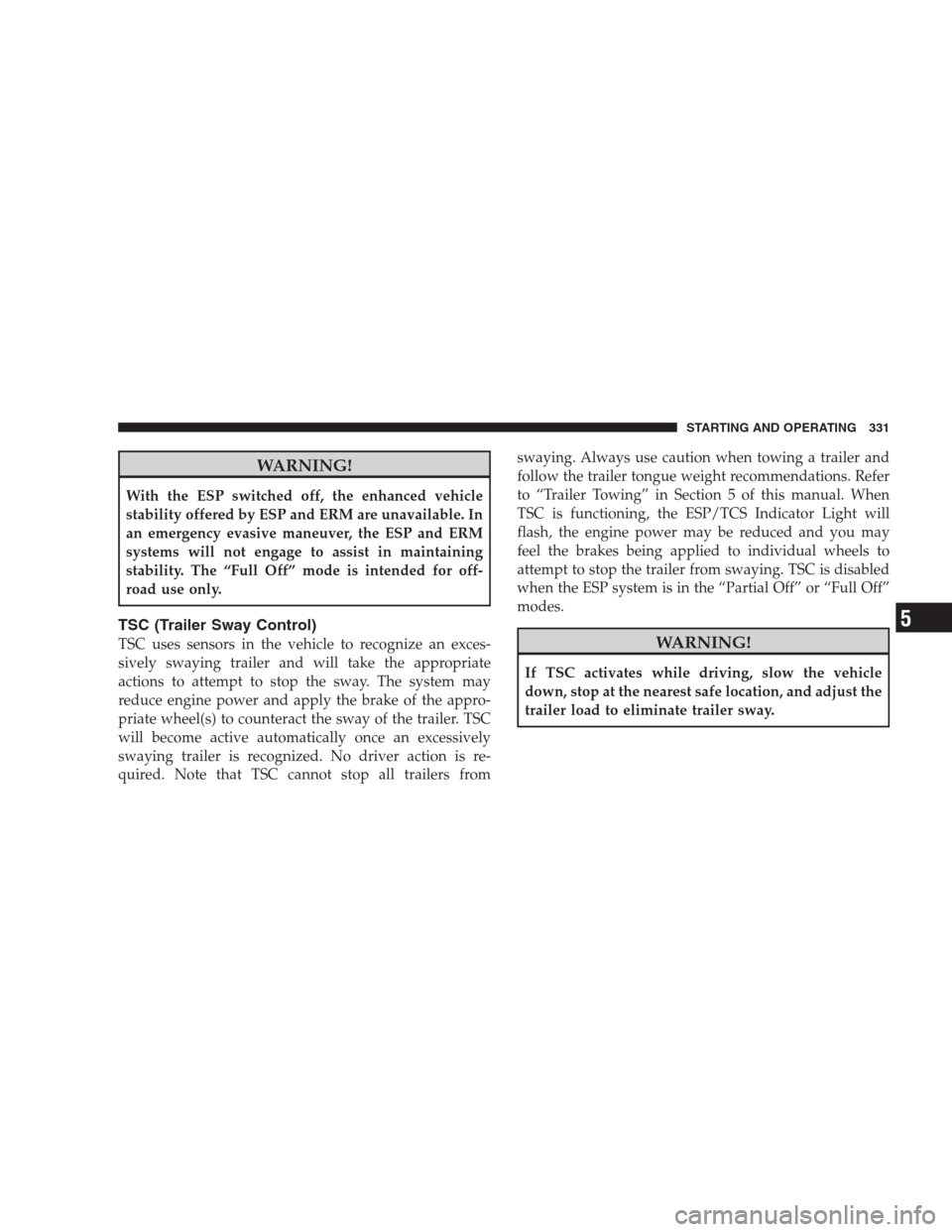
WARNING!
With the ESP switched off, the enhanced vehicle
stability offered by ESP and ERM are unavailable. In
an emergency evasive maneuver, the ESP and ERM
systems will not engage to assist in maintaining
stability. The “Full Off” mode is intended for off-
road use only.
TSC (Trailer Sway Control)
TSC uses sensors in the vehicle to recognize an exces-
sively swaying trailer and will take the appropriate
actions to attempt to stop the sway. The system may
reduce engine power and apply the brake of the appro-
priate wheel(s) to counteract the sway of the trailer. TSC
will become active automatically once an excessively
swaying trailer is recognized. No driver action is re-
quired. Note that TSC cannot stop all trailers fromswaying. Always use caution when towing a trailer and
follow the trailer tongue weight recommendations. Refer
to “Trailer Towing” in Section 5 of this manual. When
TSC is functioning, the ESP/TCS Indicator Light will
flash, the engine power may be reduced and you may
feel the brakes being applied to individual wheels to
attempt to stop the trailer from swaying. TSC is disabled
when the ESP system is in the “Partial Off” or “Full Off”
modes.WARNING!
If TSC activates while driving, slow the vehicle
down, stop at the nearest safe location, and adjust the
trailer load to eliminate trailer sway.
STARTING AND OPERATING 331
5
Page 336 of 519
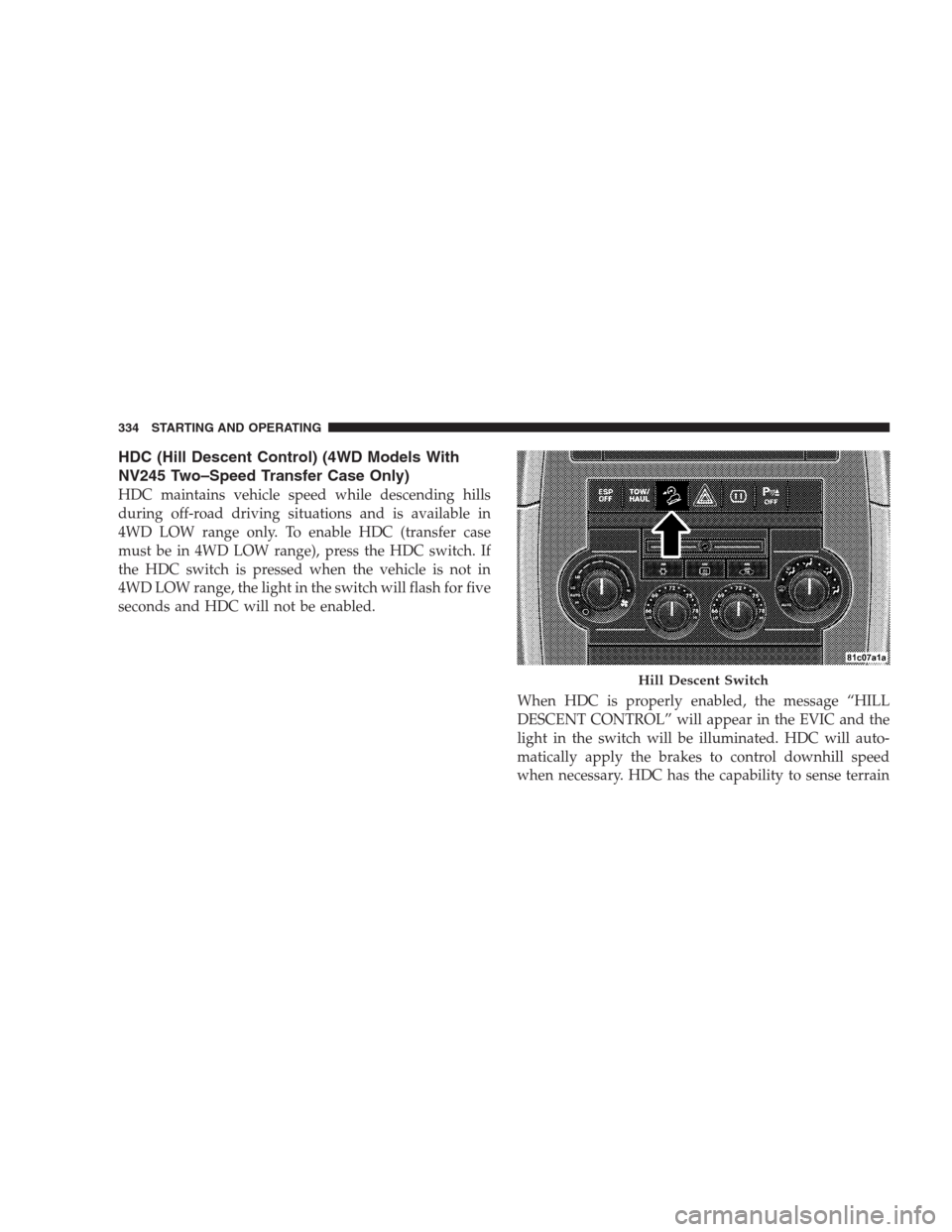
HDC (Hill Descent Control) (4WD Models With
NV245 Two–Speed Transfer Case Only)
HDC maintains vehicle speed while descending hills
during off-road driving situations and is available in
4WD LOW range only. To enable HDC (transfer case
must be in 4WD LOW range), press the HDC switch. If
the HDC switch is pressed when the vehicle is not in
4WD LOW range, the light in the switch will flash for five
seconds and HDC will not be enabled.
When HDC is properly enabled, the message “HILL
DESCENT CONTROL” will appear in the EVIC and the
light in the switch will be illuminated. HDC will auto-
matically apply the brakes to control downhill speed
when necessary. HDC has the capability to sense terrain
Hill Descent Switch
334 STARTING AND OPERATING
Page 356 of 519
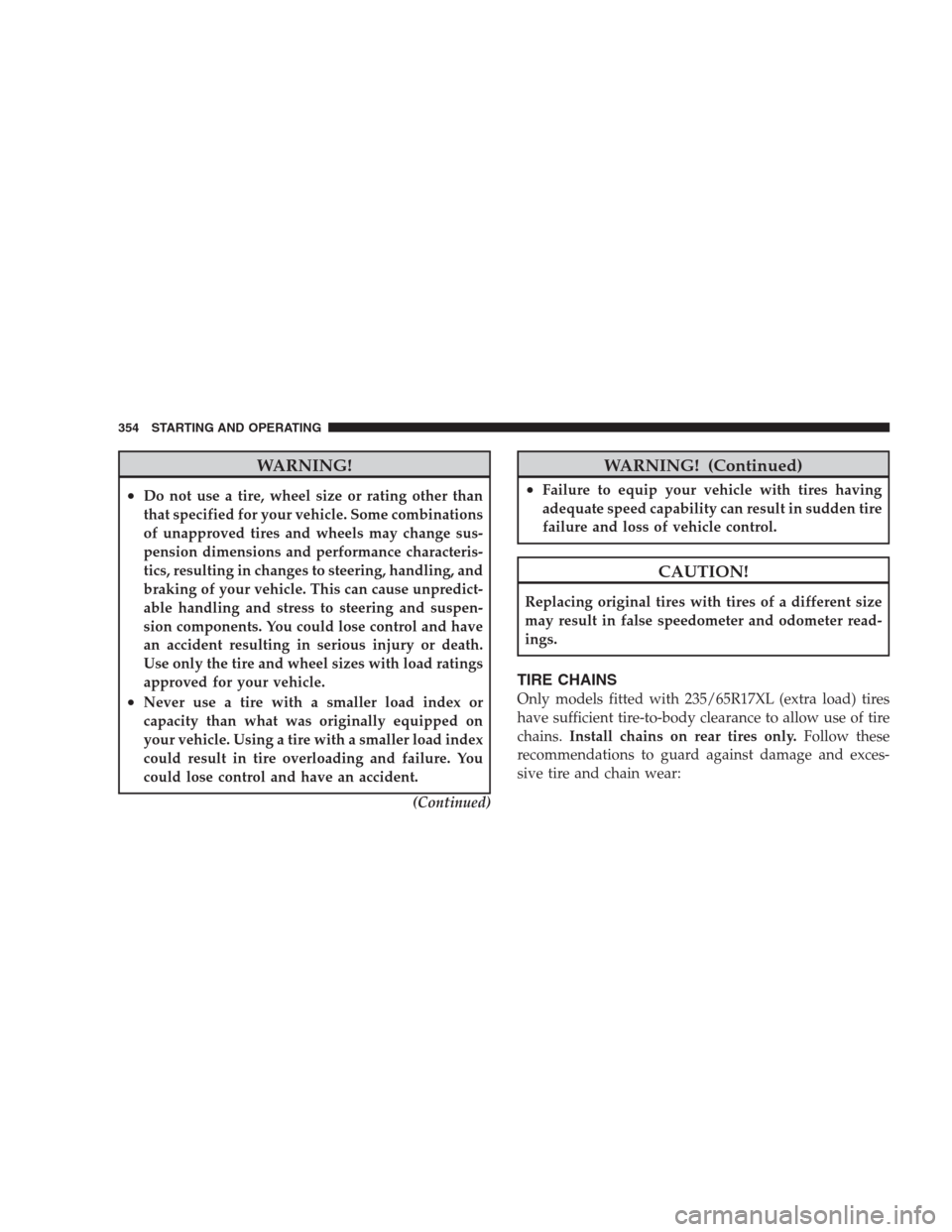
WARNING!
•Do not use a tire, wheel size or rating other than
that specified for your vehicle. Some combinations
of unapproved tires and wheels may change sus-
pension dimensions and performance characteris-
tics, resulting in changes to steering, handling, and
braking of your vehicle. This can cause unpredict-
able handling and stress to steering and suspen-
sion components. You could lose control and have
an accident resulting in serious injury or death.
Use only the tire and wheel sizes with load ratings
approved for your vehicle.
•Never use a tire with a smaller load index or
capacity than what was originally equipped on
your vehicle. Using a tire with a smaller load index
could result in tire overloading and failure. You
could lose control and have an accident.
(Continued)
WARNING! (Continued)
•Failure to equip your vehicle with tires having
adequate speed capability can result in sudden tire
failure and loss of vehicle control.
CAUTION!
Replacing original tires with tires of a different size
may result in false speedometer and odometer read-
ings.
TIRE CHAINS
Only models fitted with 235/65R17XL (extra load) tires
have sufficient tire-to-body clearance to allow use of tire
chains.Install chains on rear tires only.Follow these
recommendations to guard against damage and exces-
sive tire and chain wear:
354 STARTING AND OPERATING
Page 371 of 519
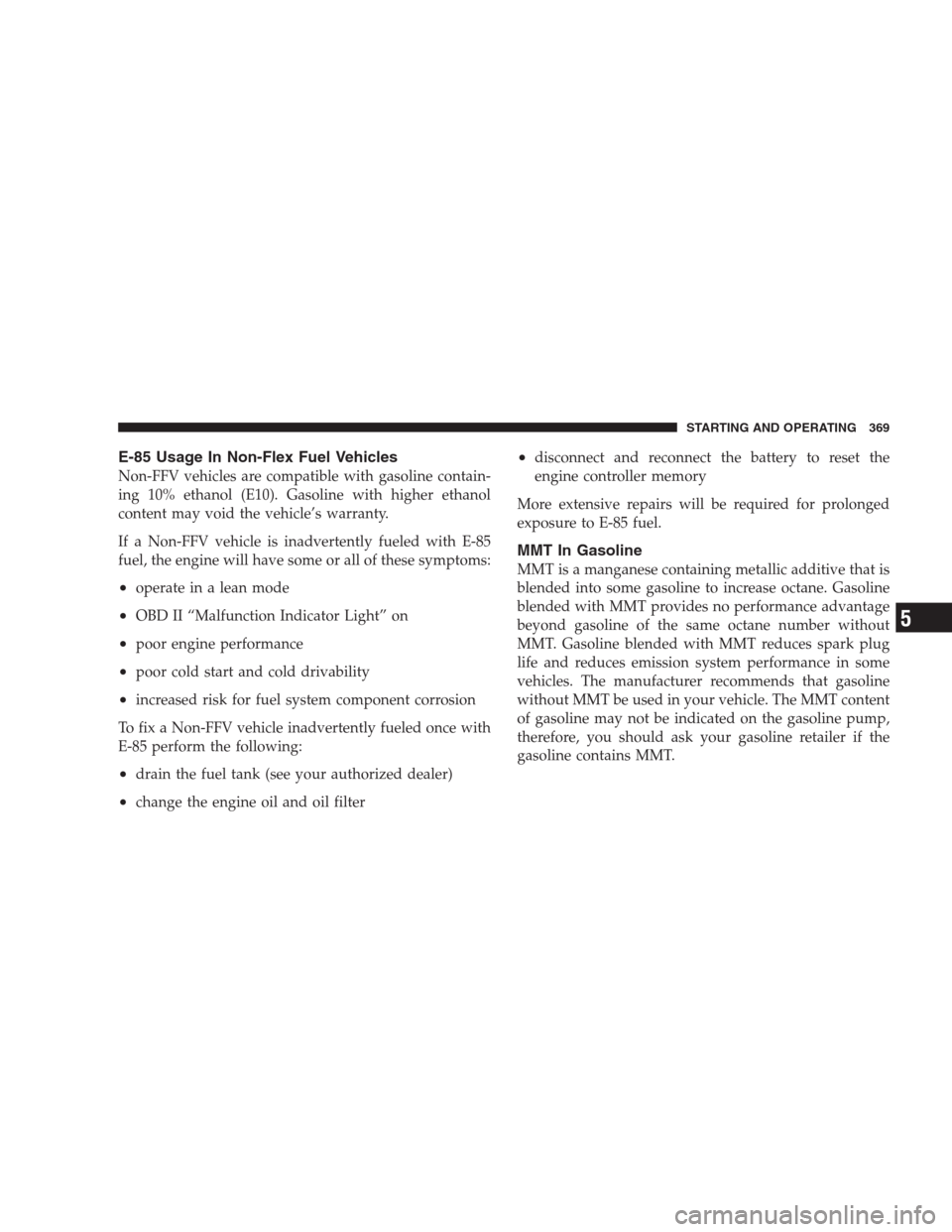
E-85 Usage In Non-Flex Fuel Vehicles
Non-FFV vehicles are compatible with gasoline contain-
ing 10% ethanol (E10). Gasoline with higher ethanol
content may void the vehicle’s warranty.
If a Non-FFV vehicle is inadvertently fueled with E-85
fuel, the engine will have some or all of these symptoms:
•operate in a lean mode
•OBD II “Malfunction Indicator Light” on
•poor engine performance
•poor cold start and cold drivability
•increased risk for fuel system component corrosion
To fix a Non-FFV vehicle inadvertently fueled once with
E-85 perform the following:
•drain the fuel tank (see your authorized dealer)
•change the engine oil and oil filter
•disconnect and reconnect the battery to reset the
engine controller memory
More extensive repairs will be required for prolonged
exposure to E-85 fuel.
MMT In Gasoline
MMT is a manganese containing metallic additive that is
blended into some gasoline to increase octane. Gasoline
blended with MMT provides no performance advantage
beyond gasoline of the same octane number without
MMT. Gasoline blended with MMT reduces spark plug
life and reduces emission system performance in some
vehicles. The manufacturer recommends that gasoline
without MMT be used in your vehicle. The MMT content
of gasoline may not be indicated on the gasoline pump,
therefore, you should ask your gasoline retailer if the
gasoline contains MMT.
STARTING AND OPERATING 369
5
Page 402 of 519
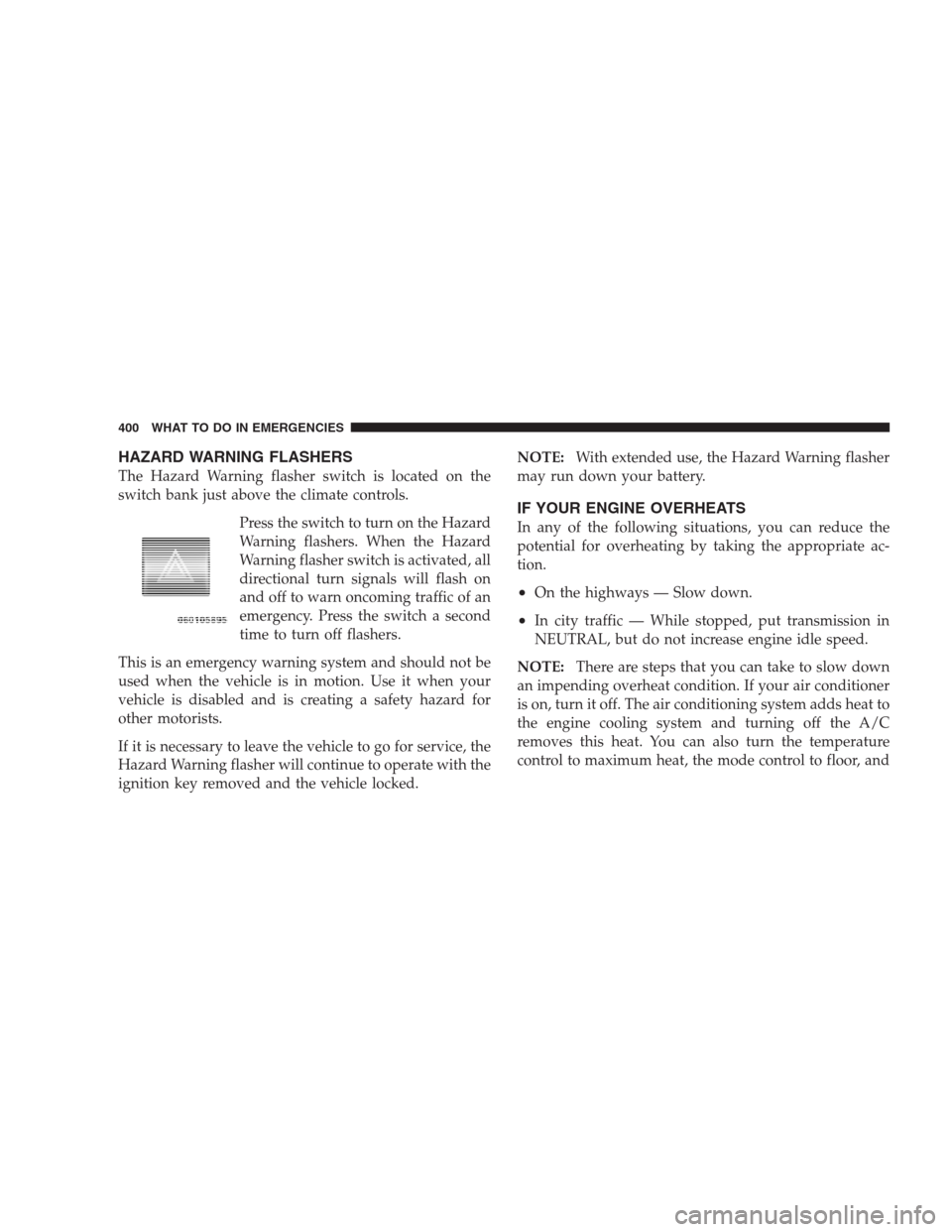
HAZARD WARNING FLASHERS
The Hazard Warning flasher switch is located on the
switch bank just above the climate controls.
Press the switch to turn on the Hazard
Warning flashers. When the Hazard
Warning flasher switch is activated, all
directional turn signals will flash on
and off to warn oncoming traffic of an
emergency. Press the switch a second
time to turn off flashers.
This is an emergency warning system and should not be
used when the vehicle is in motion. Use it when your
vehicle is disabled and is creating a safety hazard for
other motorists.
If it is necessary to leave the vehicle to go for service, the
Hazard Warning flasher will continue to operate with the
ignition key removed and the vehicle locked.NOTE:With extended use, the Hazard Warning flasher
may run down your battery.
IF YOUR ENGINE OVERHEATS
In any of the following situations, you can reduce the
potential for overheating by taking the appropriate ac-
tion.
•On the highways — Slow down.
•In city traffic — While stopped, put transmission in
NEUTRAL, but do not increase engine idle speed.
NOTE:There are steps that you can take to slow down
an impending overheat condition. If your air conditioner
is on, turn it off. The air conditioning system adds heat to
the engine cooling system and turning off the A/C
removes this heat. You can also turn the temperature
control to maximum heat, the mode control to floor, and
400 WHAT TO DO IN EMERGENCIES
Page 414 of 519
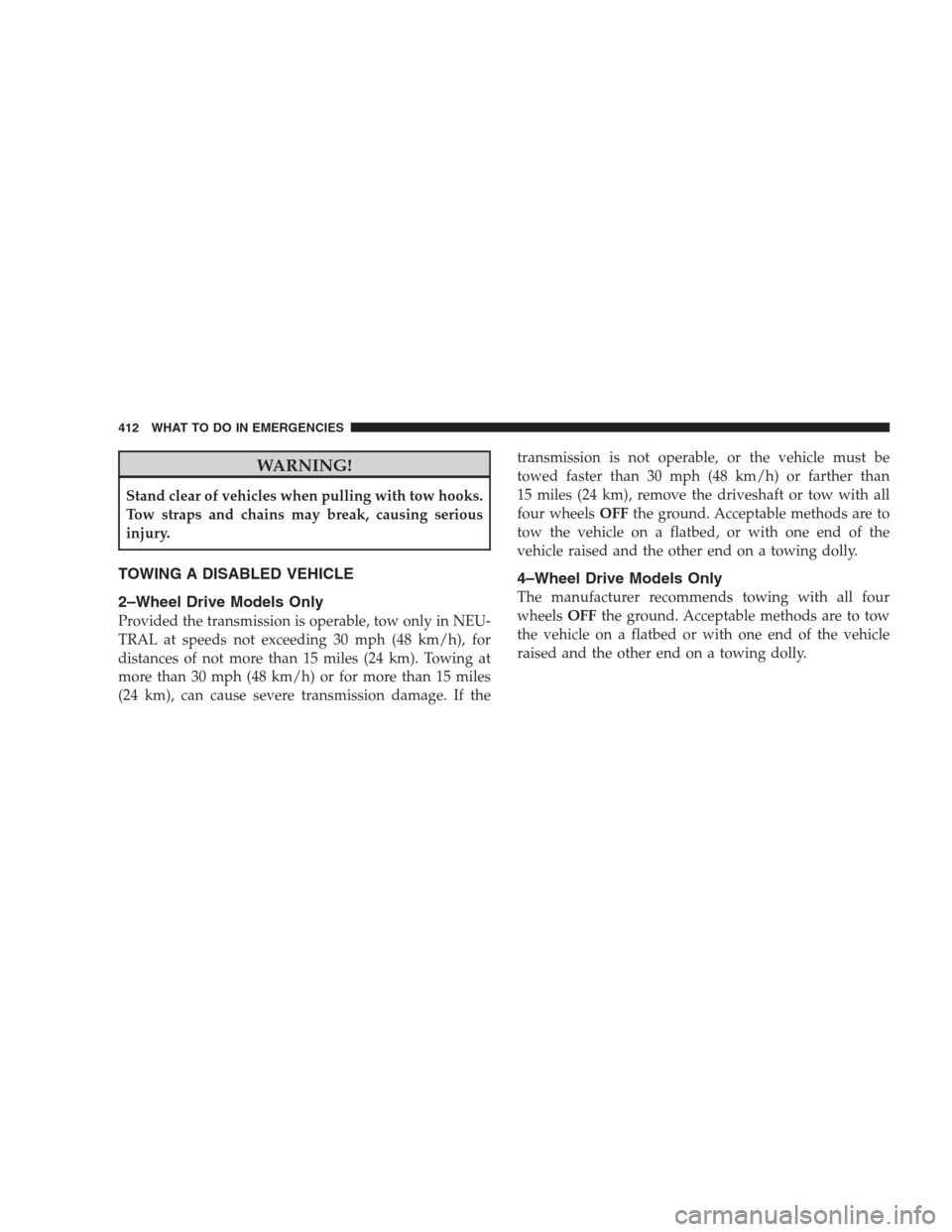
WARNING!
Stand clear of vehicles when pulling with tow hooks.
Tow straps and chains may break, causing serious
injury.
TOWING A DISABLED VEHICLE
2–Wheel Drive Models Only
Provided the transmission is operable, tow only in NEU-
TRAL at speeds not exceeding 30 mph (48 km/h), for
distances of not more than 15 miles (24 km). Towing at
more than 30 mph (48 km/h) or for more than 15 miles
(24 km), can cause severe transmission damage. If thetransmission is not operable, or the vehicle must be
towed faster than 30 mph (48 km/h) or farther than
15 miles (24 km), remove the driveshaft or tow with all
four wheelsOFFthe ground. Acceptable methods are to
tow the vehicle on a flatbed, or with one end of the
vehicle raised and the other end on a towing dolly.
4–Wheel Drive Models Only
The manufacturer recommends towing with all four
wheelsOFFthe ground. Acceptable methods are to tow
the vehicle on a flatbed or with one end of the vehicle
raised and the other end on a towing dolly.
412 WHAT TO DO IN EMERGENCIES